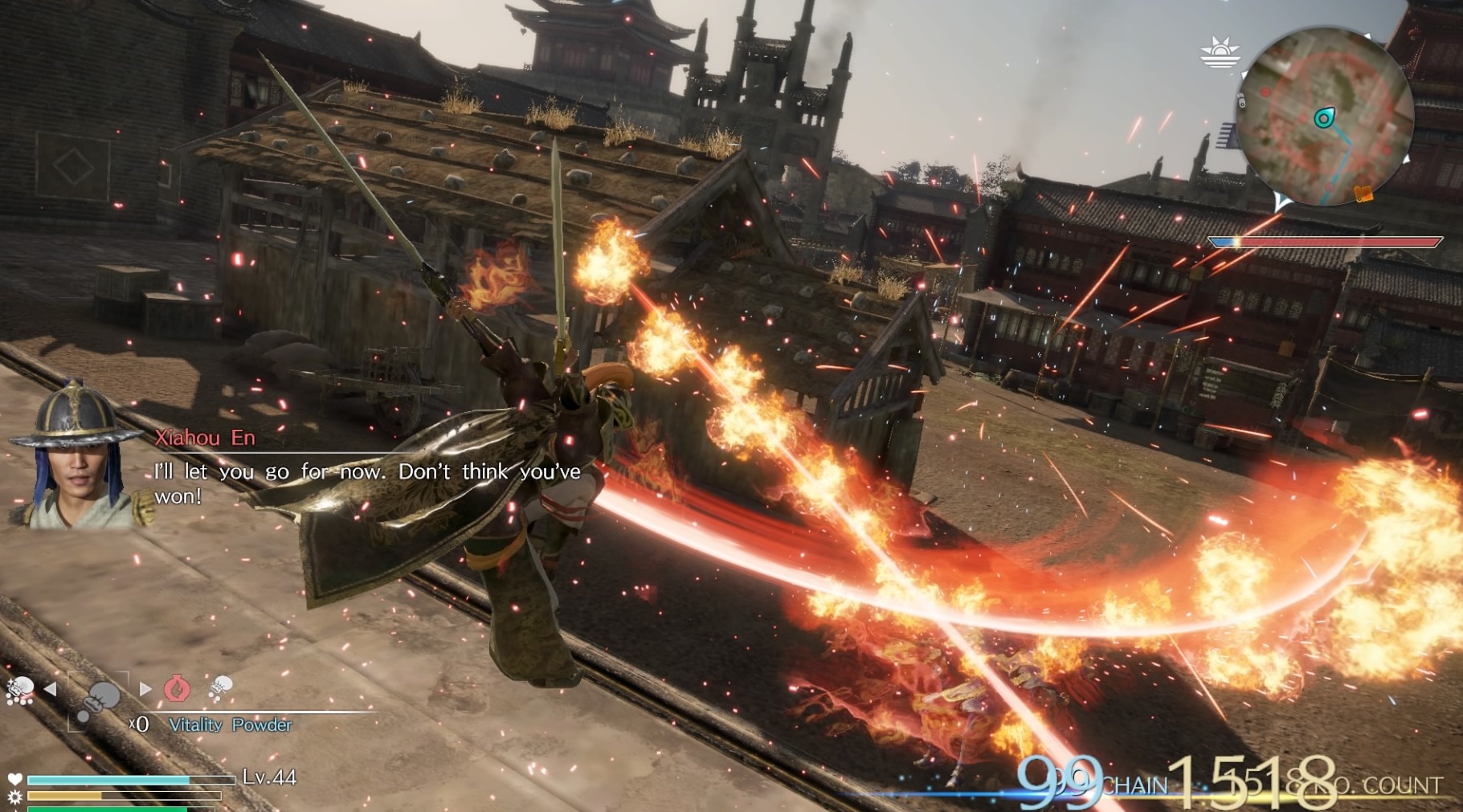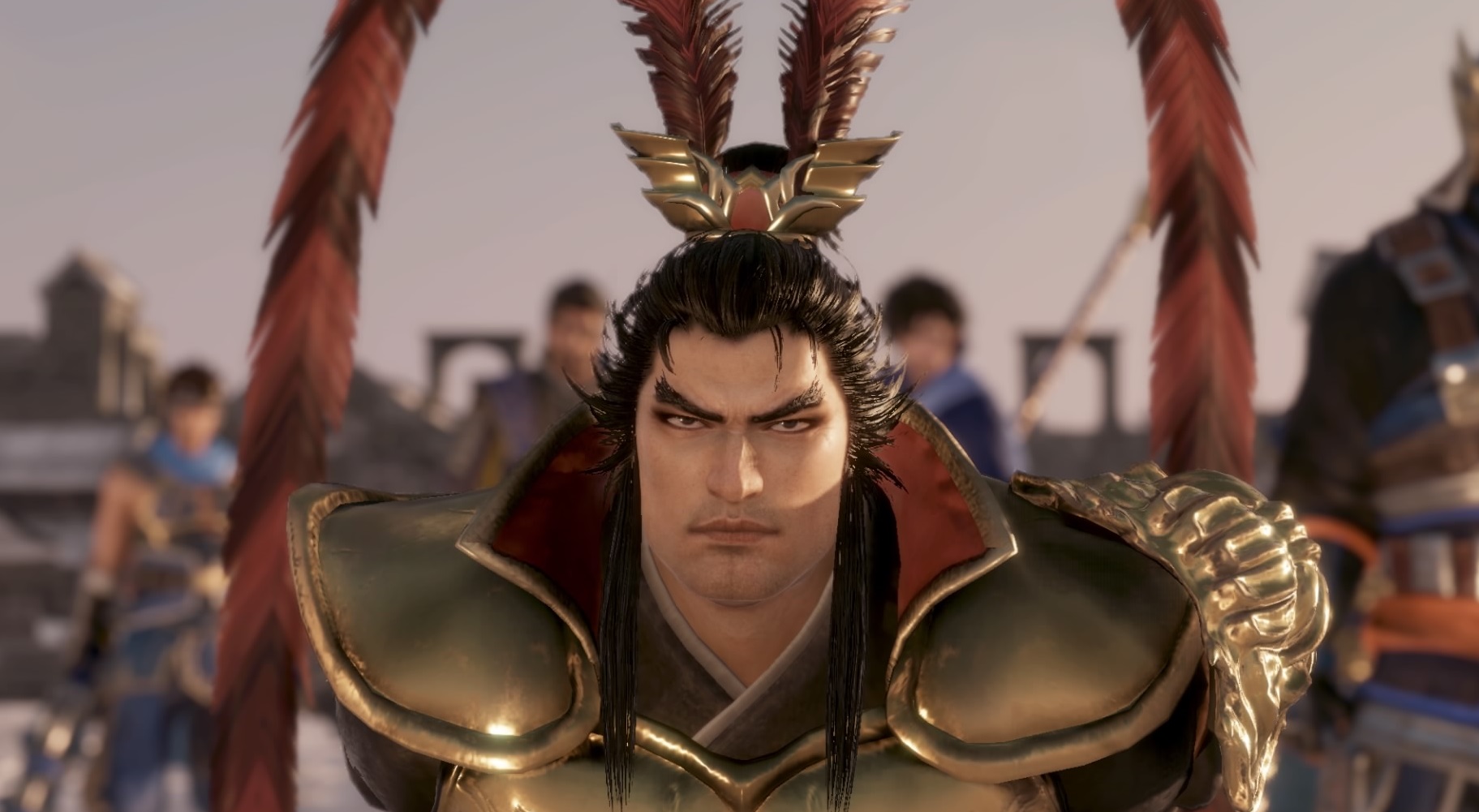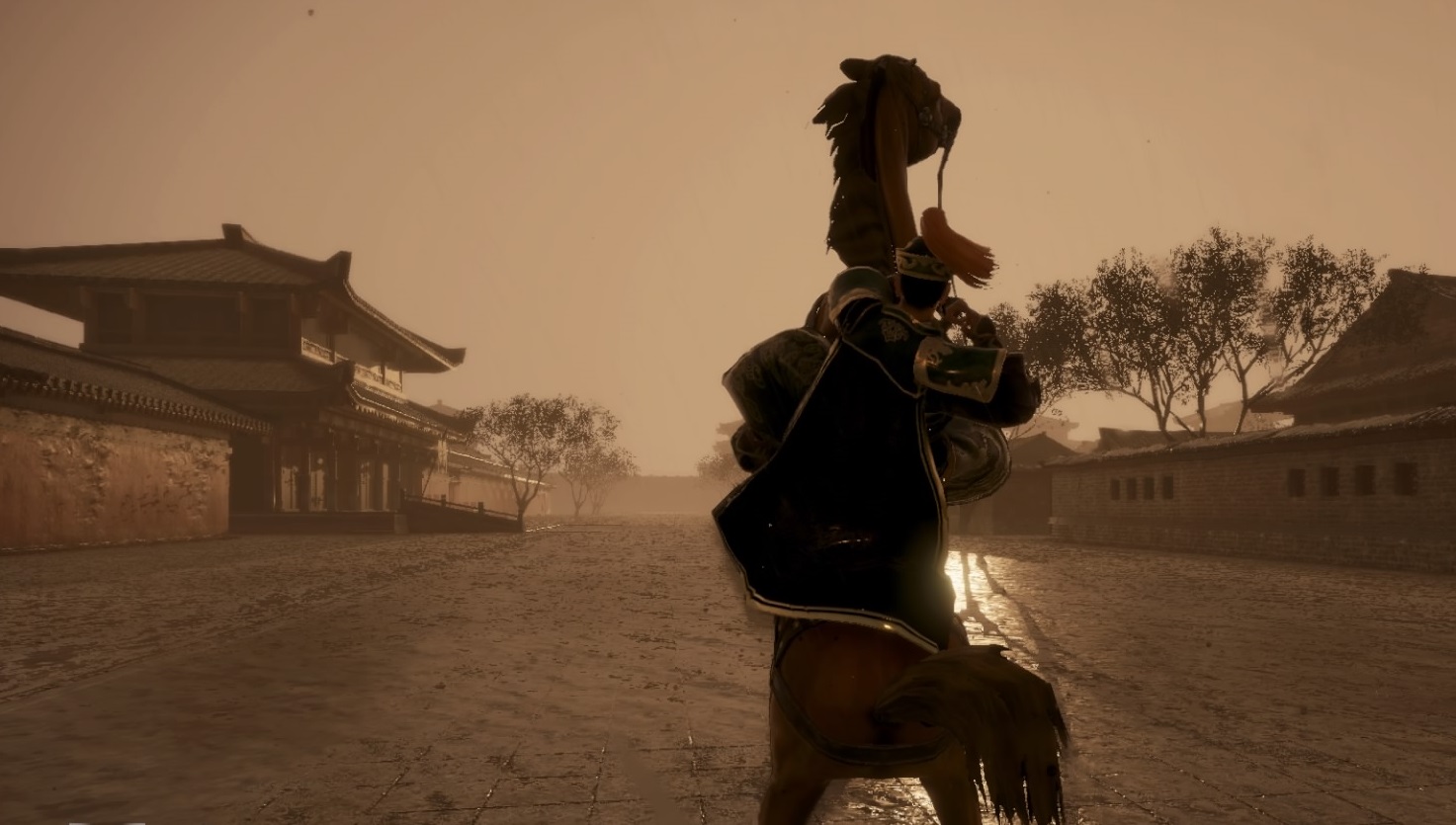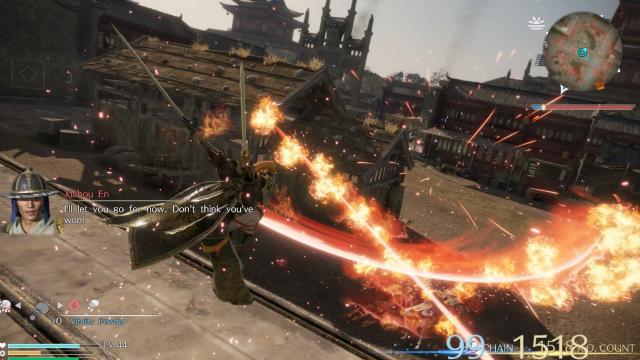If you’ve played an hour in one Dynasty Warriors game you’ve played an hour in all of them. That’s been the conventional wisdom for a while now and although Dynasty Warriors 9 doesn’t disprove it, it does point toward some interesting new possibilities for the series in its new open world setting.
Dynasty Warriors 9 is the latest game in a sweeping subgenre of 3D brawlers where you play as historical figures from 2nd and 3rd century AD China during the fall of the Han Dynasty and the ensuing civil war.
It’s been five years since the last core instalment, making this the first game built from start to finish with current gen consoles in mind. It was a rare opportunity for the series to do something truly different. Open world games aren’t as rare as they used to be, but for a conservative subgenre like the one Dynasty Warriors belongs to, it seemed like a radical new direction.
The story beats the series presents to loosely following the historical events of 2nd and 3rd century China are all there and all pretty much the same. The battle system, while tweaked and reworked as it has been with just about every new game in the series, remains recognisable to anyone who played Dynasty Warriors 2 nearly two decades ago.
You’re still selecting a hero, battling thousands over the course of their story, and getting stronger along the way.

However, the latest game dispenses with the confined levels and invisible barriers of its predecessors, instead unleashing you upon the fully-connected geographic sprawl of the late Han Empire. You can now run, or more likely gallop, from one edge of the map to the other, all while individual battles are occurring depending on where you’re at in the story.
If the objective is to storm and retake a castle, you might be encouraged to complete some smaller missions along the way that will help your forces further expand, or you can always try to run in solo and take on everyone all by yourself.
Either way, everything will happen in real time unless occasionally punctuated by some lovingly awful cutscene (what would a Dynasty Warriors game be without atrocious writing and voice acting?)
The breadth of options this opens up is at first exhilarating. Playing the game as Lui Bei, the Shu Han warrior of Destiny of an Emperor fame, I often took time away from the battlefield to tend to the new sim elements. For instance, in Dynasty Warriors 9 you can trap animals, cook, and eat them to get special status boosts just like In The Legend of Zelda: Breath of the Wild.
The game also has another mainstay of Zelda games now: fishing. It’s not a very fun or interesting diversion. You simply – surprise! – click square a bunch of times to reel your catch in. So far I’ve only gotten rusted kettles, but the fact that at any point I could go fishing gives Dynasty Warriors 9 a dimension past games didn’t have.
Whether it’s collecting ore off the ground for better horseshoes or crafting tiger fangs into gems, the non-combat activities are a nice way of breaking up the usual monotony of these games.
You can also capture hideouts in the game, which effectively operate like small houses. You can buy and stock them with special furniture, either for the simple aesthetics of it or for access to other distractions like crafting items. Just don’t bother taking the boar you killed back home, unless you’ve bought a stove.
You can also pick up a writing desk which will allow you to write letters to other characters who then might come and visit you, sometimes bringing gifts and unlocking brief side-conversations. I bought a small chair and placed it in the middle of the house because the shopkeeper’s description said it was good for hosting special guests.
Getting other warriors to show up for tea will make them more powerful when you’re fighting side-by-side during battle but so far I haven’t built up my relationships enough to make this happen.
[review image=”https://i.kinja-img.com/gawker-media/image/upload/t_original/zp29tabqvucdaa3jhqxm.jpg” heading=”Dynasty Warriors 9″ label1=”BACK OF THE BOX QUOTE” description1=””Lu who?”” label2=”TYPE OF GAME” description2=”Equestrian Racer” label3=”DEVELOPER” description3=”Omega Force” label4=”PLATFORMS” description4=”PS4 (played), Xbox One, PC” label5=”LIKED” description5=”Decorating my house, lighting dudes on fire with magic sword attacks, taking a nap to change the weather before a big fight.” label6=”DISLIKED” description6=”Frequent texture pop-in, frame rate drops, and lack of hard boss fights.” label7=”RELEASE DATE” description7=”Now” label8=”PLAYED” description8=”20 hours to complete the campaign once and then about five more trying different characters out.”]
Nevertheless, I’ve enjoyed visiting my hideout and looking out at the surrounding lands while thinking of what to do next. A robust fast-travel system means you can select locations currently within your forces’ or neutral forces’ control and appear there within a few seconds.
For all the spaces in-between, you can gallop across almost anything but the steepest inclines using your horse. It can sprint for short distances based on the size of its stamina bar, which grows the more you use it and has a vertical leap twice its height. Like most open world horses it will appear instantly whenever you whistle for it, always from just off screen and if you hold down the button you can hop on without it ever stopping.
It can swim too. The horse is Dynasty Warrior 9′s MVP.
Unfortunately, all of these elements, curious and charming on their own, don’t build to much. The game’s open world is refreshingly grey and subdued compared to some of the oversaturated colours and high contrasts of games like Horizon Zero Dawn and Dragon Age: Inquisition, but also more empty.
Dynasty Warriors 9 hasn’t drifted far from the arcade beat’em up at its heart, just layered some additional systems. The world is populated with friendly fighters or ones to be killed, but few bystanders. Fortresses sit like doll houses, elaborately detailed but devoid of the bodies that bring them to life with their mundane labour.
At one point I had to cross a river in a small fleet as part of a military manoeuvre ahead of a large battle. I never came across another soul.
Most egregiously though is how the game’s devotion to rehashing the same familiar battles and plot points – newly formed alliances ending in betrayal and fire ships – means it is constantly reshaping the world and erasing your work. Progress is broken up into chapters.
You might spend several hours methodically racking up military victories, taking over important fortresses, and generally spreading your influence only to see it all reset once you compete that chapter’s overarching objective and move onto the next one. What good is an open world if you ultimately have so little freedom to leave your mark on it?

This critical failure to recognise what makes an open world setting so enticing in the first place is then compounded by the game’s strangely frictionless battles. Taking over an area means killing the highest ranking officer(s) in charge of it, whether that’s a named character or simply a generic “captain.”
These fights are incredibly easy unless you push the difficulty to the hardest setting. Even then they are rarely challenging as opposed to just longer and more tedious. A lot of the tension of the best Dynasty Warriors battles have to do with using your god-like powers to try and achieve secondary objectives like protecting another character or pushing forward fast enough to increase your side’s fighting morale and thus its overall strength.
The open world nature of Dynasty Warriors 9 stretches these conflicts out and flattens them such that the larger war is waged in piece-meal brawls where little is ever at risk.
Take how it handles one of the series’ most famous encounters. “Do not pursue Lu Bu.” It’s a warning that’s been echoed in every Dynasty Warriors game since the second. He doesn’t flinch and will kill you within a few hits. That’s why you’re supposed to sneak past him as he fights with your AI-controlled companions.
He’s not part of the objective, and while left to his own devices he can single-handedly destroy your entire army, it’s easy enough to run through the doors of the gate he guards and move on to the real target, his boss, Dong Zhou.
Running away from fights is not what Dynasty Warriors is about though. Whether it’s you versus 100 or a 1,000, the satisfaction of a Dynasty Warriors game comes in methodically employing a few simple weapon combos to overcome any enemy, anywhere, at any time. The command not to pursue Lu Bu is just its way of underlining this fact through a coy bit of reverse psychology. It’s a brutal undertaking to try and beat him on the first playthrough but everyone wants to see if they can.
When I met Lu Bu for the first time in Dynasty Warriors 9 during the Battle of Hulao Pass I ignored my comrades and tried my luck. Thirty seconds later I watched him disappear from the battlefield and collected the meager loot he left behind. With side missions and a conventional levelling system it’s easy to grind and outpace your opponents in the game, but the game breaches this cardinal rule of punishing you for picking a fight with Lu Bu.
That’s too much. Even on hard, there’s practically no fight in the game you can’t win by using simple combos and deploying your musou abilities to obliterate opponent’s’ life bars. By the end of the game I routinely beelined for boss strongholds, grapple hooked over the walls, and then tore through the enemy force in no time.
Dynasty Warriors games are more often cheap in the arcade-sense than challenging in the modern sense, but Dynasty Warriors 9 is neither.
Gone is the the rock-paper-scissors affinity triangle many players grumbled about from Dynasty Warriors 8. Instead of relying on certain weapons to overcome opposing weapon guards, the current game returns to the straightforward brute-force method of overcoming foes: hit them with everything you have until they die.
In practice this means using the game’s new trigger system by holding down R1 and then pressing one of the face buttons to unleash a special attack that might stagger whoever you’re fighting. While all of the animations for these abilities are different, they mostly achieve the same thing.
If you’re fighting a named officer who’s stubbornly blocking all of you’re regular attacks, you can always try throwing them to the ground or flipping them into the air. Maybe you’ll find an opening or maybe you won’t. In either case you’ll keep on hitting them until eventually they’re dead.

When enemies get weak or are far away, new “reactive” attacks, also known as “press triangle to smash” are also an option. They are essentially shortcuts, similar to the combo prompts in the Arkham and Shadow of Mordor games, that allow you to spend less time not engaging with enemies.
At first they were a relief – no flailing at thin air waiting for a combo to end long after my opponent had bit the dust (in Dynasty Warriors every second not spent hitting something feels like an eternity). In the latter part of the game they made everything feel too easy. It’s a fine line between feeling like an efficient killing machine and someone torpedoing barrels of fish, and on more occasion than one Dynasty Warriors 9 veers clumsily toward the latter.
What it lacks in difficulty it makes up for in quantity. Never have so many button presses been required to accomplish so little. “My dear, here we must run as fast as we can, just to stay in place. And if you wish to go anywhere you must run twice as fast as that,” the Red Queen says in Alice in Wonderland, and that’s exactly what goes on here. No matter how many waves of enemies you rip through there always seem to be more.
On the one hand this is the joy of a Dynasty Warriors game – entering a trance-like state where simple button mashing is transformed from clumsy nonsense into beautifully coordinated,deadly gymnastics. Here, the drama of these individual moments has been diluted by virtue of taking place in a large open world while still ultimately being untethered to it since the board is continually washed clean with each new plot development.
The last thing I did in Dynasty Warriors 9 was stand outside my house on top of a mountain looking out at a star-filled sky. It was a relaxing break from the slaughter the series is known for and the closest I got to understanding and appreciating the promise of what an open world Dynasty Warriors game might be.
Battles were raging and allies were calling for help, but for once the game offered me the option of deserting the fray and contemplating the larger world around it. It’s a shame that everything else in the game works so emphatically against it.

Comments
7 responses to “Dynasty Warriors 9: The Kotaku Review”
I don’t know if you’ve ever played a Dynasty Warriors game and judging that you avoided mentioning anything about the elephant in the room, I’m guessing not.
But WHERE THE HELL IS THE MULTIPLAYER?
Nearly 20 games (including spin-offs/alternative universes) and they decide to drop the co-op…the thing that keeps people coming back.
“Oh it’s too hard to keep beautiful 4k output while having 2 players, but we’ve turned it into an MMO instead! 😀 ” – Every development company past 2014
Was so hyped for this but holy fuck is it awful. Never has an open world felt so empty and unnecessary…. Fuck hunting. Fuck the bugs. Fuck the dollar store voice acting. Fuck the horribly outdated graphics which still managed to drop like a stone on multiple occasions. Fuck the utterly lazy and uninspired characters. This is worse than DW6.
I havent been this utterly disappointed since FFXIII. I love my DW games to death but I wont try and defend this abortion of a game…..
I think I’m going to be avoiding this one. Open world shenanigans doesn’t sound like something i’d want in a Warriors game.
I think the open world, if they can make it busier, will be a bigger opportunity for the Empire release. Have 6 or 7 battles going on at once, give them a reasonable time so that they finish without you forcing you to choose which battles will be more important to attend to personally and actually giving a better chance of putting your empire at risk because you couldn’t be everywhere at once. It might even open up choices like being at the first half of one battle just to see that it starts right and leaving to see if you can make the second half of another. It could be very good, so long as they ramp the difficulty up.
But the base game sounds like I’ll wait for it to hit $15 to play, which makes me sad
Sadly I’m in the “long term fan – can’t stand it so far” camp…
I want to love it but just finding it so, so tedious at present. There’s always been repetition, but I personally found it cathartic – in DW9 it’s more lethargic though? I’ll persevere a little, but with Fire Emblem Warriors DLC due soon & perhaps 75% of Monster Hunter left for me to play/kill there’s barely even a twitch in the “should i play DW9 right now depaetment” – a far cry from my usual DW love affair 🙁
This game is an utter abomination that wouldn’t score well on a PS2. I watched Jim Stirling’s play through vid…..what a trainwreck of a game. Wouldn’t look out of place in the $5 section of the cesspit that is Steam.